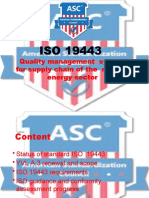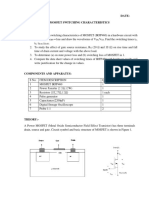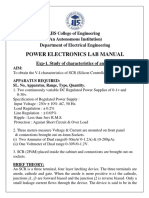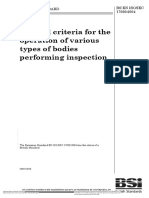Process Control Lab Manual
Uploaded by
Rakesh Kumar PatnaikProcess Control Lab Manual
Uploaded by
Rakesh Kumar PatnaikJAGANNATHINSTITUTEFORTECHNOLOGYAND MANAGEMENT
PROCESSCONTROLLABMANUAL
JAGANNATHINSTITUTEFORTECHNOLOGYANDMANAGEMENT ALLURI NAGAR,PARALAKHEMUNDI
PROCESS CONTROL LAB (CPEN 9405) MANUAL Content
1. To study the V-I Characteristic of SCR using PEC16M1A. 2. To study the V-I Characteristics of TRIAC by using PEC16M1A 3. To study the V-I Characteristics of DIAC by using PEC16M1A 4. To study the open loop response of a simple process. 5. To study the closed response of a simple process. 6. To observe the time response of the closed loop second order process with the proportional control. 7. To study the time response of P+I controller. 8. To study the response of P+I+D controller in a process. 9. To study the action of ON/ OFF control of a temperature control system using VTCS-02 10. To study the action of proportional control on a temperature control system using VTCS-02 11. To study the action of PID controller on a temperature control system using VTCS-02 12. To study the opening v/s flow characteristics of the control valve.
DEPARTMENT OF ELECTRONICS & INSTRUMENTATION ENGINEERING
PROCESS CONTROL LAB (CPEN 9405) MANUAL
EXPERIMENT:-1
Aim of the Experiment: To study the V-I Characteristic of SCR using PEC16M1A. Apparatus Required: 1. PEC16M1A Trainer 2. Ammeter (0-200mA) MC 2Nos. 3. Voltmeter (0-30V) MC. 4. Patch chords Theory: An SCR is a type of rectifier, controlled by a logic gate signal. It is a four-layer, three-terminal device. A p-type layer acts as an anode and an n-type layer as a cathode; the p-type layer closer to the n-type (cathode) acts as a gate. In the normal "off" state, the device restricts current to the leakage current. When the gate to cathode voltage exceeds a certain threshold, the device turns "on" and conducts current. The device will remain in the "on" state even after gate current is removed so long as current through the device remains above the holding current. Once current falls below the holding current for an appropriate period of time, the device will switch "OFF". If the applied voltage increases rapidly enough, capacitive coupling may induce enough charge into the gate to trigger the device into the "on" state; this is referred to as "dv/dt triggering." This is usually prevented by limiting the rate of voltage rise across the device, perhaps by using a snubber. "dv/dt triggering" may not switch the SCR into full conduction rapidly and the partially-triggered SCR may dissipate more power than is usual, possibly harming the device. SCRs can also be triggered by increasing the forward voltage beyond their rated breakdown voltage (also called as break over voltage), but again, this does not rapidly switch the entire device into conduction and so may be harmful so this mode of operation is also usually avoided. Also, the actual breakdown voltage may be substantially higher than the rated breakdown voltage, so the exact trigger point will vary from device to device. SCRs are made with voltage ratings of up to 7500 volts, and with current ratings up to 3000 RMS amperes per device. Some of the larger ones can take over 50 kA in single-pulse operation. SCRs are
DEPARTMENT OF ELECTRONICS & INSTRUMENTATION ENGINEERING
PROCESS CONTROL LAB (CPEN 9405) MANUAL
used in power switching, phase control, chopper, battery chargers, and inverter circuits. Industrially they are applied to produce variable DC voltages for motors (from a few to several thousand HP) from AC line voltage. They control the bulk of the dimmers used in stage lighting, and can also be used in some electric vehicles to modulate the working voltage in a Jacobson circuit. Another common application is phase control circuits used with inductive loads. SCRs can also be found in welding power supplies where they are used to maintain a constant output current or voltage. Large silicon-controlled rectifer assemblies with many individual devices connected in series are used in high-voltage DC converter stations. Two SCRs in "inverse parallel" are often used in place of a TRIAC for switching inductive loads on AC circuits. Because each SCR only conducts for half of the power cycle and is reverse-biased for the other half-cycle, turn-off of the SCRs is assured. By comparison, the TRIAC is capable of conducting current in both directions and assuring that it switches "off" during the brief zero-crossing of current can be difficult. Typical electrostatic discharge (ESD) protection structures in integrated circuits produce a parasitic SCR. This SCR is undesired; if by accident it is triggered, then the IC will go into latchup and may be destroyed. Circuit Diagram:
Connection Procedure: Connect the SCR anode, cathode, gate terminal to SCR Characteristic circuit Connect the ammeter in anode terminal as indicated in the connection diagram
DEPARTMENT OF ELECTRONICS & INSTRUMENTATION ENGINEERING
PROCESS CONTROL LAB (CPEN 9405) MANUAL
Connect the ammeter is gate terminal Connect the voltmeter to across of anode and cathode terminal Experimental Procedure: 1. Switch on the 230V AC Supply. 2. Now vary the pot3 and set the gate current (IG) in the range of 4mA to 5mA. 3. Now slowly increase the anode-cathode voltage (VAK) by varying the pot4 till the Thyristor get turned on, note down the ammeter (IA), Voltmeter (VAK) readings. 4. For various gate current take the reading and Tabulate in Table 1. 5. Plot the graph VAK Vs IA in a graph sheet. 6. After note down the max anode current remove the gate current by switch OFF the switch S1. 7. Now reduce the anode voltage (VAK) gradually, at on stage the node current will suddenly reach zero value. The current at this stage is holding current (IH). 8. Now switch ON the switch S1 and vary the anode cathode voltage (VAK) slightly, now again switch OFF the switch S1. If the anode current shows zero value again switch ON S1 and vary the anode cathode voltage. If the anode current shows some value , i.e., the latching current of SCR. Tabulation: Sl.No. IG = VAK IA VAK IG = IA
DEPARTMENT OF ELECTRONICS & INSTRUMENTATION ENGINEERING
PROCESS CONTROL LAB (CPEN 9405) MANUAL
Model Graph:
Result: Thus the V-I = ------------------------= ------------------------= ------------------------= ------------------------characteristic of SCR were drawn and note down the following values from the graph sheet. 1. Latching current (IL) 2. Holding current (IH) 3. Gate Current (IG) 4. Break over Voltage (VAK)
DEPARTMENT OF ELECTRONICS & INSTRUMENTATION ENGINEERING
PROCESS CONTROL LAB (CPEN 9405) MANUAL EXPERIMENT:-2
Aim of the Experiment: To study the V-I Characteristics of TRIAC by using PEC16M1A Apparatus Required: 5. PEC16M1A Trainer 6. Ammeter (0-200mA) MC 2Nos. 7. Voltmeter (0-30V) MC. 8. Patch chords Theory: A TRIAC, or Triode for Alternating Current is an electronic component approximately equivalent to two silicon-controlled rectifiers (SCRs/thyristors) joined in inverse parallel (paralleled but with the polarity reversed) and with their gates connected together. Formal name for a TRIAC is bidirectional triode thyristor. This results in a bidirectional electronic switch which can conduct current in either direction when it is triggered (turned on). It can be triggered by either a positive or a negative voltage being applied to its gate electrode (with respect to A1, otherwise known as MT1). Once triggered, the device continues to conduct until the current through it drops below a certain threshold value, such as at the end of a half-cycle of alternating current (AC) mains power. This makes the TRIAC a very convenient switch for AC circuits, allowing the control of very large power flows with milliampere-scale control currents. In addition, applying a trigger pulse at a controllable point in an AC cycle allows one to control the percentage of current that flows through the TRIAC to the load (so-called phase control). Low power TRIACs are used in many applications such as light dimmers, speed controls for electric fans and other electric motors, and in the modern computerized control circuits of many household small and major appliances. However, when used with inductive loads such as electric fans, care must be taken to assure that the TRIAC will turn off correctly at the end of each half-cycle of the ac power.
DEPARTMENT OF ELECTRONICS & INSTRUMENTATION ENGINEERING
PROCESS CONTROL LAB (CPEN 9405) MANUAL
Circuit Diagram:
Connection Procedure: Connect the MT2 terminal of TRIAC is positive w.r.t. MT1 and gate current also positive. Connect the ammeter in anode terminal as indicated in the connection diagram. Connect the ammeter is gate terminal as indicated in the connection diagram. Connect the voltmeter in between TRIAC MT1 and MT2.
Experimental Procedure: 1. Now switch on the 230V AC Supply. 2. Now vary the pot3 and set the gate current IG. 3. Now slowly increase the MT1 and MT2 voltage by varying the pot4 till the TRIAC is turned on and note the voltage (VMT1) , current (IF) readings as shown in table. 4. Now measure the break over voltage VBO1. 5. Further increase MT1 - MT2 voltage and note the current IA . 6. Plot the VF Vs IF in a graph sheet.
DEPARTMENT OF ELECTRONICS & INSTRUMENTATION ENGINEERING
PROCESS CONTROL LAB (CPEN 9405) MANUAL
Tabulation: Sl.No. IG = VMT1 IA IG = VMT1 IF
Model Graph:
Result: Thus the V-I Characteristics of TRIAC were studied and notedown the following values from the graph sheet. Latching Current (IL) Holding Current (IH) Gate Current (IG) Break Over Voltage (VAK) = ________________________ = ________________________ = ________________________ = ________________________
DEPARTMENT OF ELECTRONICS & INSTRUMENTATION ENGINEERING
PROCESS CONTROL LAB (CPEN 9405) MANUAL EXPERIMENT:-3
Aim of the Experiment: To study the V-I Characteristics of DIAC by using PEC16M1A Apparatus Required: 1. PEC16M1A Trainer 2. Ammeter (0-200mA) MC 2Nos. 3. Voltmeter (0-30V) MC. 4. Variable DC Power Supply 5. Patch chords Theory: The DIAC, or diode for alternating current, is a bidirectional trigger diode that conducts current only after its breakdown voltage has been exceeded momentarily. When this occurs, the resistance of the diode abruptly decreases, leading to a sharp decrease in the voltage drop across the diode and, usually, a sharp increase in current flow through the diode. The diode remains "in conduction" until the current flow through it drops below a value characteristic for the device, called the holding current. Below this value, the diode switches back to its high-resistance (non-conducting) state. When used in AC applications this automatically happens when the current reverses polarity. The behavior is typically the same for both directions of current flow. Most DIACs have a breakdown voltage around 30 V. In this way, their behavior is somewhat similar to (but much more precisely controlled and taking place at lower voltages than) a neon lamp. DIACs are a form of thyristor but without a gate electrode. They are typically used for triggering both thyristors and TRIACs - a bidirectional member of the thyristor family. Because of this common usage, many TRIACs contain a built-in DIAC in series with the TRIAC's "gate" terminal. DIACs are also called symmetrical trigger diodes due to the symmetry of their characteristic curve. Because DIACs are bidirectional devices, their terminals are not labeled as anode or cathode but as A1 and A2 or MT1 ("Main Terminal") and MT2.
10
DEPARTMENT OF ELECTRONICS & INSTRUMENTATION ENGINEERING
PROCESS CONTROL LAB (CPEN 9405) MANUAL
Circuit Diagram:
Procedure: 1. Made Connections as per the the circuit diagram. 2. Vary the voltage linearly by varying the input dc voltage till the DIAC get turned ON. 3. Note down the ammeter (IA) and voltmeter (VA) readings and note down the break over voltage 4. Plo the VA Vs IA in graph sheet. 5. Now change the DIAC MT2 is positive with respect to MT1. 6. Repeat the same procedure and plot the graph. Tabulation: SL. NO. VOLTAGE(VA) CURRENT(IA)
11
DEPARTMENT OF ELECTRONICS & INSTRUMENTATION ENGINEERING
PROCESS CONTROL LAB (CPEN 9405) MANUAL
Model Graph:
Result: Thus the V-I Characteristic of DIAC were studied.
12
DEPARTMENT OF ELECTRONICS & INSTRUMENTATION ENGINEERING
PROCESS CONTROL LAB (CPEN 9405) MANUAL EXPERIMENT:-4
Aim of the experiment:- To study the open loop response of a simple process. Procedure:1. Patch the front panel of the PCS-01 as in figure. 2. Keep the process fast/slow switch (SW4) in slow position. 3. Using this set value control, attempt to make measured value meter to indicate any desired value. 4. Note down the relative readings of both measured value and set value meters. 5. Then apply a small disturbing voltage of 1 v DC to the load disturbance socket from DC voltage source. 6. Note down the changes in measured value meter. Tabulation:Sl. No. Set Value Measured (No Load) Value Measured (With Load) Value
13
DEPARTMENT OF ELECTRONICS & INSTRUMENTATION ENGINEERING
PROCESS CONTROL LAB (CPEN 9405) MANUAL
Conclusion:As long as the other conditions are constant, the measured values are also constant. When the load is disturbed no corrective action occurs. In furnace for example if the some of the heat is removed and no adjustment is made to the power level, the actual temperature or measured value may well rise above the desired value. The system is now needs to be modified, so that it can correct itself for any changes in operating conditions. This can be achieved by closing the loo.
14
DEPARTMENT OF ELECTRONICS & INSTRUMENTATION ENGINEERING
PROCESS CONTROL LAB (CPEN 9405) MANUAL EXPERIMENT:-5
Aim of the experiment: - To study the closed response of a simple process. Summary:There are three main features of such a system. A comparison is made between the set value and
measured value to reduce the deviation. Deviation = Set value Measured value. Deviation operates the system and there is a power gain. Procedure:1. Make the connections as per the front panel diagram as shown in the figure. 2. Keep the process fast/slow switch (SW4) in slow position. 3. Change the set value, and note the corresponding changes on set value and measured value meters and also note down the deviation. 4. Then apply a voltage of approximately 1 v to the load disturbance socket. 5. Note down the changes in measured value and deviation.
15
DEPARTMENT OF ELECTRONICS & INSTRUMENTATION ENGINEERING
PROCESS CONTROL LAB (CPEN 9405) MANUAL
Tabulation:S. No Set value No Load Measured Deviation Value With Load Measured Deviation Value
Conclusion:When change in set value is made the measured value changes, but somewhat slower than the set value and the measured value is not as same as the set value. When load disturbance is applied to both the measured value and the deviation changes. The delay in the change of the measured value is due to lags in the process.
16
DEPARTMENT OF ELECTRONICS & INSTRUMENTATION ENGINEERING
PROCESS CONTROL LAB (CPEN 9405) MANUAL EXPERIMENT:-6
Aim of the experiment:To observe the time response of the closed loop second order process with the proportional control. Summary:The system considered in experiment 3 had one major disadvantage, namely that there is considerable deviation present at all times. As deviation should operate the system, this implies that sensitivity is too low. In process control this sensitivity is defined I terms of the proportional and. This is the range of values of deviation that causes the controller output to cover its full operating range. This is often expressed as a percentage such that 100% proportional band means the full range of outputs of the measuring systems causes the controller to operate over its full range. Adjustments of the percentage of the proportional band vary with the gain of the controller. The following experiment will examine the effects of the changes in percentage of the proportional band and response of the system to disturbances. Procedure:1. Patch the front panel of PCS-01 as shown in figure. 2. Set the process fast/slow switch (sw4) in fast position. 3. Keep the set value pot to zero. 4. Apply a square wave signal of 2V p-p at around 50 Hz. 5. Alternatively display I the oscilloscope the set value disturbance point and measured value from the point PV. 6. Repeat all the above tests with the percentage proportional band 50% and 40%. 7. As each step is applied to the system response as.
17
DEPARTMENT OF ELECTRONICS & INSTRUMENTATION ENGINEERING
PROCESS CONTROL LAB (CPEN 9405) MANUAL
Response of the system:
Tabulation:% PB Peak overshoot MP Rise time t r Peak time t p Damping Ratio Setting time ts
18
DEPARTMENT OF ELECTRONICS & INSTRUMENTATION ENGINEERING
PROCESS CONTROL LAB (CPEN 9405) MANUAL
Conclusion:The system moves slowly towards the set value, overshoots, returns and after a few oscillations settles so that the measured value is less than the set value as shown in figure-32.When it has settled there exists a considerable deviation as shown figure-33. As the percentage proportional band is reduced, i.e. the gain of the system is increased by, KP = 100%/PB% As this steady state deviation is reduced and the system settles with its measured value much closer to set value.
19
DEPARTMENT OF ELECTRONICS & INSTRUMENTATION ENGINEERING
PROCESS CONTROL LAB (CPEN 9405) MANUAL EXPERIMENT:-7
Aim of the experiment:- To study the time response of P+I controller. Summary:The proportional control to maintain a stable system the gain level is such that the system is insensitive to deviation below the certain level. In an ideal system the measured value and the set value should be the same under steady state condition the deviation should be zero. What is required is an alternative signal to be fed into the main amplifier of sufficient size to provide an output if a steady state deviation exists viz to reduce the offset to zero. Such a signal can be provided by an integer or which gives a constantly increasing output for a steady value input. Such an arrangement is known as proportional +integral controller and should reduce any steady state deviation to zero. Procedure:1. Connections are given as shown in figure. 2. Set the process fast/slow switch (SW4) and controller fast/slow switch (SW3) in fast position. 3. Keep the set value pot to zero. 4. Apply a square wave of 2V P-P at around 50 Hz. 5. Adjust the proportional band control until the system settles with 2 to 3 overshoots. 6. Now connect the integral section as shown I figure-36. 7. Slowly reduce the integral action time until the deviation falls to zero. 8. Monitor both the set value disturbance socket and PV socket. The typical output waveform is as shown in figure.
20
DEPARTMENT OF ELECTRONICS & INSTRUMENTATION ENGINEERING
PROCESS CONTROL LAB (CPEN 9405) MANUAL
Tabulation:S. No. Proportional band PB Integral time Peak Overshoot MP Rise time Tr Setting time Ts
Conclusion:By suitable adjustment of an integrator section output the steady state deviation can be reduced to zero. In consequence the measured value becomes much closer to set value. Too much integral term however causes the system to go into oscillation. Generally speaking an increase in integral time reduces the steady state deviation but increases the time of the system takes to settle.
21
DEPARTMENT OF ELECTRONICS & INSTRUMENTATION ENGINEERING
PROCESS CONTROL LAB (CPEN 9405) MANUAL Experiment-8
Aim of the experiment:- To study the response of P+I+D controller in a process. Summary:As seen in experiment no 5 the integral control improves the performance of the control system in some respects, I.e. it reduces the steady state deviation, but has the disadvantage of slowing down the over all response time. If a system is required to follow a sudden change in set value this would give rse to a rapid change in the deviation. Although this deviation change is rapid the system response rather slowly, so if at this time the controller output can be boosted, the speed of the system response will be improved. If the deviation is differentiated, i.e. rate of change of measured, and a signal is produced proportional to this and than added to the signal from the proportional and integrator sections, some improvements may results such an arrangement is known as three term controller or PID controller. PID Controller Response:
Procedure:1. Connections are given as shown in figure. 2. Set the process fast/slow switch (SW4) and controller fast/slow switch (SW3) in fast position. 3. Keep the set value pot to zero. 4. Apply a square wave of 2V P-P at around 50 Hz. 5. Now patch I and I and adjust the integral time until the steady state deviation is zero.
22
DEPARTMENT OF ELECTRONICS & INSTRUMENTATION ENGINEERING
PROCESS CONTROL LAB (CPEN 9405) MANUAL
6. Now note down the number of overshoots before the system settles. 7. Now connect D and D and increase the derivative time and note down the effect of the system response. Tabulation:Proportional band Integral time Rise time Tr Peak time Tp Setting time Ts Peak overshoot
Conclusion: The response of the P-I-D controller studied successfully.
23
DEPARTMENT OF ELECTRONICS & INSTRUMENTATION ENGINEERING
PROCESS CONTROL LAB (CPEN 9405) MANUAL Experiment-9
Aim of the Experiment: To study the action of ON/ OFF control of a temperature control system using VTCS-02 Equipment Required: 1. Temperature control system (VTCS02) 2. Patch Cords 3. Heater setup 4. Thermistor Sensor Theory: Two position control is a position type of controller action in which the manipulated variable is quickly changed to either a maximum or minimum value depending on whether the process variable is greater or lesser than the set point. Without Overlap: In a two step-controller the output signal changes from one predetermined value to another when the deviation changes sign. This leads to a system in which the controlled condition alternates above and below a mean value at a frequency determined by the energy level at which the correcting elements operate.
With
24
DEPARTMENT OF ELECTRONICS & INSTRUMENTATION ENGINEERING
PROCESS CONTROL LAB (CPEN 9405) MANUAL
overlap applied the controller changes to its higher value when the process variable falls below a lower limit and to its lower value when the process variable exceeds an upper limit. Over lap: Over lap is the region in which the control causes the manipulated variable to maintain its previous value until the controlled variable has moved slightly beyond the set point. Small overlap is not preferred because it will introduce oscillation as and reduce the life of final control element.
Procedure: 1. Interface the heater, blower, Thermistor with VTCS-02 2. Keep the ON-OFF/ PID switch in ON-OFF position, SW-1 should be in downward direction. 3. Keep the overlap POT at minimum position 4. Set the desired temperature (35-95oC) by varying the set value POT 5. Switch on the heater and blower. Blower should not be switched on before heater switching. 6. Tune the overlap to maintain the process variable at set point. 7. View the response for different set points and throttle opening. Results: Thus the ON-OFF control action on temperature process control system was studied.
25
DEPARTMENT OF ELECTRONICS & INSTRUMENTATION ENGINEERING
PROCESS CONTROL LAB (CPEN 9405) MANUAL Experiment-10
Aim of the Experiment: To study the action of proportional control on a temperature control system using VTCS-02 Equipment Required: 5. Temperature control system (VTCS02) 6. Patch Cords 7. Heater setup 8. Thermistor Sensor 9. Blower Theory: Two position controls applied to a process results in a continuous oscillation in the quantity to be controlled. This draw back was overcome by a continuous control action which could maintain a continuous balance of the input and output. Proportional control is defined as follows. It is a controller action in which there is a continuous linear relation between the value of the controlled variable and position of the final controlled element within the proportional band.
Controller Output = kp (Err) + Bias. PB = (Full Scale Deviation / KC) 100 Offset, the sustained deviation always present in proportional control is dependent on the proportional bandwidth. As proportional band is decreased, deviation is reduced until a point is reached at which the system become unstable.
26
DEPARTMENT OF ELECTRONICS & INSTRUMENTATION ENGINEERING
PROCESS CONTROL LAB (CPEN 9405) MANUAL
Procedure: 8. Interface the heater, blower, Thermistor with VTCS-02 9. Keep the ON-OFF/ PID switch in PID position, SW-2 should be in downward direction. 10. Patch the proportional control section (P-P1) 11. Set the desired temperature (35-95oC) by varying the set value POT 12. Switch on the heater and blower. Blower should not be switched on before heater switching. 13. Tune the proportional band to maintain the process variable at set point. 14. View the response for different set points and proportional band.
Supply Disturbance: A step change in set point is produced by SW-2 toggle, switch and immediate change in controller output and delayed responses in measured value due to distance/ velocity and transfer lag. Results: Thus the proportional control action on temperature process control system was studied.
27
DEPARTMENT OF ELECTRONICS & INSTRUMENTATION ENGINEERING
PROCESS CONTROL LAB (CPEN 9405) MANUAL Experiment-11
Aim of the Experiment: To study the action of PID controller on a temperature control system using VTCS-02 Equipment Required: 10. Temperature control system (VTCS02) 11. Patch Cords 12. Heater setup 13. Thermistor Sensor 14. Blower Theory:
CO = K p ( Err) + ( Err)dt +
0
d ( Err) + Bias dt
The three mode controller contains the stability of proportional control and the ability to eliminate offset because of reset (integral). Control and the ability provide an immediate correction for the magnitude of a disturbance because of rate (derivative) control.
Procedure: 1. Interface the heater, blower, Thermistor with VTCS-02 2. Keep the ON-OFF/ PID switch in PID position, SW-2 should be in downward direction.
28
DEPARTMENT OF ELECTRONICS & INSTRUMENTATION ENGINEERING
PROCESS CONTROL LAB (CPEN 9405) MANUAL
3. Patch the proportional control section (P-P1), (I-I1) and (D-D1) 4. Set the desired temperature (35-95oC) by varying the set value POT 5. Switch on the heater and blower. Blower should not be switched on before heater switching. 6. Tune the proportional band, Ti, Td potentiometers to maintain the process variable at set point. 7. View the response for different set points and PID values.
Supply Disturbance: A step change in set point is produced by SW-2 toggle, switch and immediate change in controller output and delayed responses in measured value due to distance/ velocity and transfer lag. Results: Thus the proportional control action on temperature process control system was studied.
29
DEPARTMENT OF ELECTRONICS & INSTRUMENTATION ENGINEERING
PROCESS CONTROL LAB (CPEN 9405) MANUAL EXPERIMENT-12
Aim of the Experiment: To study the opening v/s flow characteristics of the control valve. Apparatus Required: 1. Compressor 2. Pump 3. Control Valve 4. Level Indicator Theory: The control valve is essentially a variable resistance to the flow of a fluid, in which the resistance and therefore the flow can be changed by a signal from a process controller. The control valve consists of an actuator and a valve. The valve itself divided into the body and the trim. The body consists of housing for mounting the actuator and connections for attachment of the trim, which is enclosed within the body. The body consists of a plug, a valve seat and a valve steam. The actuator moves the valve steam as the pressure on a spring loaded diaphragm. The steam moves a plug in a valve seat in order to change the resistance to flow through the valve. When a valve is supplied by the manufacturer the actuator and the valve are attached to each other to form one unit. Valve Characteristics: The function of the control valve is to vary the flow of the fluid through the valve by means of a change of pressure to the valve top. The relation between the flow through the valve and the valve steam position is called Valve Characteristics. In general the flow through a control valve for a specific fluid at a given temperature can be expressed: Q=f (L, P0, P1). Where Q=Volumetric flow rate L=Valve steam position P0=Up steam pressure P1=Down Steam pressure. Valve can be dividing into 3 types decreasing sensitivity, linear and Increasing sensitivity. Fractional flow m is plotted against fractional lift x. For the decreasing sensitivity, the sensitivity decreases with m. For the linear type sensitivity is constant and the characteristic curve is a straight line. For the increasing sensitivity type, the sensitivity increases with flow m.
30
DEPARTMENT OF ELECTRONICS & INSTRUMENTATION ENGINEERING
PROCESS CONTROL LAB (CPEN 9405) MANUAL
Control Valve:
The relation between flow and steam position for a valve installed in a process line will be called the effective valve characteristic.
31
DEPARTMENT OF ELECTRONICS & INSTRUMENTATION ENGINEERING
PROCESS CONTROL LAB (CPEN 9405) MANUAL
Procedure: 1. Fill the reservoir with water and then switch on the compressor pump. 2. Open the two valves of water and air to the control valve (Cn) to permit the follow of air and water. 3. Close the valve Cn in air at zero pressure, and then note the maximum flow from Rota meter. 4. Note and tabulate the different valve opening flow rate. 5. Close the air and water inlet valve. 6. Open the valve Cn at high pressure. Then measure the minimum flow rate at maximum lift of valve 7. Again tabulate the different valve opening flow rate. And Plot the graph. Tabulation: Air to Open: Scale of control valve Flow rate in LPH %ge of Lift %ge of Flow
Air to Close: Scale of control valve Flow rate in LPH %ge of Lift %ge of Flow
Conclusion The control valve CV1 was found to be Linear one where the valve CV2 equal percentage type.
32
DEPARTMENT OF ELECTRONICS & INSTRUMENTATION ENGINEERING
You might also like
- Telecom Interview Questions Answers Guide PDF50% (2)Telecom Interview Questions Answers Guide PDF10 pages
- Instrumentation & Process Control Lab Manual80% (5)Instrumentation & Process Control Lab Manual38 pages
- Feed Forward and Cascade Control Experiment100% (1)Feed Forward and Cascade Control Experiment28 pages
- Simulation of Some Power System, Control System and Power Electronics Case Studies Using Matlab and PowerWorld SimulatorFrom EverandSimulation of Some Power System, Control System and Power Electronics Case Studies Using Matlab and PowerWorld SimulatorNo ratings yet
- Computer-Based Industrial Control by Krishna Kant29% (7)Computer-Based Industrial Control by Krishna Kant112 pages
- School of Chemical and Materials Engineering NUST: Instrumentation and Process Control Laboratory (List of Experiments)No ratings yetSchool of Chemical and Materials Engineering NUST: Instrumentation and Process Control Laboratory (List of Experiments)2 pages
- Experiment Kit For Study of Sample and Hold Circuit: User ManualNo ratings yetExperiment Kit For Study of Sample and Hold Circuit: User Manual24 pages
- Experiment No.1 Time Response of First Order System: 1.matlab ProgramNo ratings yetExperiment No.1 Time Response of First Order System: 1.matlab Program5 pages
- Obt751 - Analytical Methods and Instrumentation Lecture - 2100% (1)Obt751 - Analytical Methods and Instrumentation Lecture - 228 pages
- EI8651-Logic and Distributed Control System PDFNo ratings yetEI8651-Logic and Distributed Control System PDF17 pages
- Lecture 4A SignalConditioning DCBRIDGE SVNo ratings yetLecture 4A SignalConditioning DCBRIDGE SV48 pages
- Data Acquisition and Signal Conditioning Circuits in The Industry0% (1)Data Acquisition and Signal Conditioning Circuits in The Industry21 pages
- Microprocessor-Based Agri Instrumentation: Krishna KantNo ratings yetMicroprocessor-Based Agri Instrumentation: Krishna Kant11 pages
- Week 2-Process and Instrumentation Diagram100% (1)Week 2-Process and Instrumentation Diagram31 pages
- Closed Loop Response of Temperature Control SystemNo ratings yetClosed Loop Response of Temperature Control System6 pages
- Process Control: Version 2 EE IIT, Kharagpur 1No ratings yetProcess Control: Version 2 EE IIT, Kharagpur 113 pages
- Biosensors and Instrumentation: Lecture 1: Introduction To Chemical Sensors & BiosensorsNo ratings yetBiosensors and Instrumentation: Lecture 1: Introduction To Chemical Sensors & Biosensors2 pages
- Transducers and Data Acquisition SystemsNo ratings yetTransducers and Data Acquisition Systems176 pages
- Instrumentation and Measurement Project Report PDFNo ratings yetInstrumentation and Measurement Project Report PDF13 pages
- EE3511 PED LAB MANUAL - STUDENT COPY reg2021No ratings yetEE3511 PED LAB MANUAL - STUDENT COPY reg202167 pages
- BGRL (Satara-Sangli) - Spur Spread-3 - JP-Clearing & Grading - R0 - Code A - 26.02.2021No ratings yetBGRL (Satara-Sangli) - Spur Spread-3 - JP-Clearing & Grading - R0 - Code A - 26.02.202110 pages
- Modul VB6 Mandiri INDRAES Input Cari Hapus Edit BarangNo ratings yetModul VB6 Mandiri INDRAES Input Cari Hapus Edit Barang112 pages
- Chapter 4: Product and Service Design: Goods and Services It Offers Capability of An Organization ToNo ratings yetChapter 4: Product and Service Design: Goods and Services It Offers Capability of An Organization To12 pages
- Media and Information Literacy: I. Multiple Choice. Read The Questions Carefully and Encircle The Letter of Your ChoiceNo ratings yetMedia and Information Literacy: I. Multiple Choice. Read The Questions Carefully and Encircle The Letter of Your Choice4 pages
- Solid-State Transformer For Energy Efficiency EnhaNo ratings yetSolid-State Transformer For Energy Efficiency Enha24 pages
- Lecture 6: Instruction Set Architectures III - Last Time: ISA Design PrinciplesNo ratings yetLecture 6: Instruction Set Architectures III - Last Time: ISA Design Principles10 pages
- EPM-IT0-TP-000001 - 02 Project Information & Communications Technology Plan TemplateNo ratings yetEPM-IT0-TP-000001 - 02 Project Information & Communications Technology Plan Template11 pages
- High Performance Data Bus Encoding Technique in DSM TechnologyNo ratings yetHigh Performance Data Bus Encoding Technique in DSM Technology5 pages
- Which of The Following Is Not Recommended For Change Implementation?No ratings yetWhich of The Following Is Not Recommended For Change Implementation?5 pages

























































































